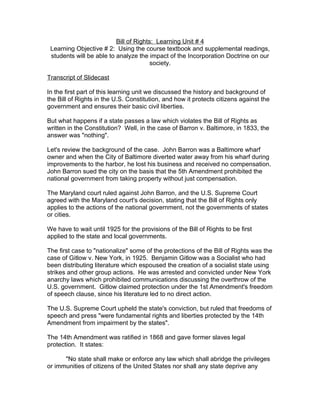
Bill of rights lo#2 slidecast
- 1. Bill of Rights: Learning Unit # 4 Learning Objective # 2: Using the course textbook and supplemental readings, students will be able to analyze the impact of the Incorporation Doctrine on our society. Transcript of Slidecast In the first part of this learning unit we discussed the history and background of the Bill of Rights in the U.S. Constitution, and how it protects citizens against the government and ensures their basic civil liberties. But what happens if a state passes a law which violates the Bill of Rights as written in the Constitution? Well, in the case of Barron v. Baltimore, in 1833, the answer was "nothing". Let's review the background of the case. John Barron was a Baltimore wharf owner and when the City of Baltimore diverted water away from his wharf during improvements to the harbor, he lost his business and received no compensation. John Barron sued the city on the basis that the 5th Amendment prohibited the national government from taking property without just compensation. The Maryland court ruled against John Barron, and the U.S. Supreme Court agreed with the Maryland court's decision, stating that the Bill of Rights only applies to the actions of the national government, not the governments of states or cities. We have to wait until 1925 for the provisions of the Bill of Rights to be first applied to the state and local governments. The first case to "nationalize" some of the protections of the Bill of Rights was the case of Gitlow v. New York, in 1925. Benjamin Gitlow was a Socialist who had been distributing literature which espoused the creation of a socialist state using strikes and other group actions. He was arrested and convicted under New York anarchy laws which prohibited communications discussing the overthrow of the U.S. government. Gitlow claimed protection under the 1st Amendment's freedom of speech clause, since his literature led to no direct action. The U.S. Supreme Court upheld the state's conviction, but ruled that freedoms of speech and press "were fundamental rights and liberties protected by the 14th Amendment from impairment by the states". The 14th Amendment was ratified in 1868 and gave former slaves legal protection. It states: "No state shall make or enforce any law which shall abridge the privileges or immunities of citizens of the United States nor shall any state deprive any
- 2. person of life, liberty, or property, without due process of law; nor deny to any person within its jurisdiction the equal protection of the laws." In the decision of Gitlow v. New York, the U.S. Supreme Court ruled that the 14th Amendment prohibits states from infringing on free speech. This decision in 1925 began the development of the Incorporation Doctrine, the legal concept under which the Supreme Court has nationalized the Bill of Rights by making most of its provisions applicable to the states through the 14th Amendment. The only exceptions to this application of the Bill of Rights are the 3rd and 7th Amendments, the Grand Jury requirement of the 5th Amendment, and the prohibition of excessive fines and bails of the 8th Amendment. Let's look at a few historic examples from your text in Table 4.2, The Nationalization of the Bill of Rights. Some of the most significant cases involve the nationalization of defendant rights under the protections in the 4th through 8th Amendments. For example, the right to counsel if accused of a capital crime was not nationalized until 1932 in the case of Powell v. Alabama. Before 1932, in some states, you could be accused of a capital crime and not be entitled to legal counsel. The right to confront witnesses was not nationalized until the case of Pointer v. Texas in 1965. And the right to a jury trial for serious crimes was not nationalized until 1968 in Duncan v. Louisiana. This process of incorporation of rights has been extremely significant in the legal and social progress of our nation, as the Bill of Rights now guarantees individual freedoms against infringement by state and local governments, as well as the national government.